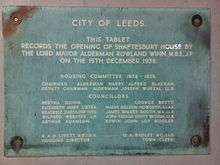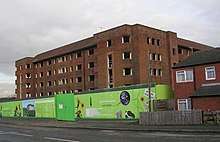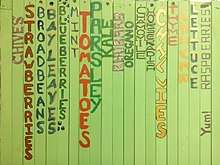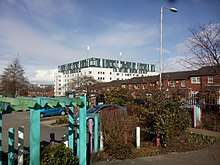Greenhouse (Leeds)
Greenhouse is an eight-storey, mixed-use block of eco-flats in Beeston, Leeds. The building took its present form in 2010, after renovation of a 1938 development, Shaftesbury House. As Shaftesbury House, the building was noted for its technologically innovative, modernist housing of migrant workers. As Greenhouse, it has been noted for an approach to promoting ecological and social sustainability far ahead of most of the UK building industry.
| Greenhouse | |
|---|---|
_winter_2020.jpg) | |
%26groups%3D_106d8f86abcf24ae2102ceb0ab787b40e923ac4b.svg)
| |
| Former names | Shaftesbury House |
| Alternative names | The Greenhouse |
| General information | |
| Architectural style | Ecomodernism (formerly Art Deco) |
| Location | Leeds, LS11 United Kingdom |
| Coordinates | 53.781465°N 1.551800°W |
| Opened | 15 December 1938 |
| Renovated | 1 October 2010 |
| Renovation cost | £12.5 million (construction cost);[1] 26-27m (overall cost)[2] |
| Landlord | GRIF—Ground Rents Income Fund Plc |
| Technical details | |
| Floor count | 8 (7 habitable) |
| Floor area | 12,623 m2 (135,870 sq ft) |
| Lifts/elevators | 2 |
| Design and construction | |
| Architect | R. A. H. Livett |
| Developer | Leeds City Council |
| Awards and prizes | yes |
| Renovating team | |
| Architect | West and Machell Architects |
| Renovating firm | Citu |
| Structural engineer | Thomasons |
| Services engineer | Arup, Woods Environmental |
| Quantity surveyor | Sum |
| Main contractor | Clegg Construction |
| Website | |
| www | |
| References | |
| [3] | |
Shaftesbury House


In the wake of the Great Depression, Leeds was host to large numbers of migrant workers, who were frequently housed in appalling conditions. A programme of slum clearance, partly driven by the Housing Act 1930 and led particularly by Charles Jenkinson, followed, described by the historian Alison Ravetz as 'a heroic age of Leeds history' and fiercely opposed by the Conservative Party.[4] Leeds City Council created the Leeds Model Lodging House in an old dyeworks in 1932, and then created the Shaftesbury House Municipal Hostel as its successor.[5] Shaftesbury House was officially opened on 15 December 1938, opposite the old Holbeck workhouse.[6] The building shared its name with Anthony Ashley-Cooper, 7th Earl of Shaftesbury, who introduced the Labouring Classes Lodging Houses Act 1851.
Art Deco in style, the building was an imposing, five-storey brick edifice, designed in 1936 by George Clark Robb,[7] then senior architectural assistant to R. A. H. Livett.[8] Square in plan, it contained four small courtyards, as many as 523 bedrooms, and numerous common spaces and shared facilities for laundry, washing, cooking, and dining.[9][10][11] It was designed to house 308 men and 196 women (in separate areas with separate entrances).[12] It had a different colour scheme for each floor,[13] along with over 60 staff, a barber's shop and a cobblers.[14] It has been seen as a major example of inter-war social housing.[15]
However, by the 1960s-70s, the development had deteriorated. While in the 1960s it was still intended as a hostel only for workers,[16] it served increasingly as a homeless shelter for the unemployed and long-term homeless, and allegedly even became known as the 'dustbin'.[17][18] It was noted among Leeds's black population for the racism of its staff and inhabitants.[19][20] It was finally closed and boarded up in November 1998.[21]
Redevelopment
_compared_with_Greenhouse_(2010).png)
_floor_3_corridor_showing_old_exterior_wall.jpg)
The small Leeds developer Citu conceived a redevelopment of Shaftesbury Hourse in 2005, and completed the purchase of the building in 2008,[22] with finance coming prominently from the Co-operative Bank.[23] The development was co-ordinated with Leeds City Council as part of the regeneration of the Holbeck/Beeston area of Leeds,[24] though local residents were not uniformly enthusiastic about the development,[25] and investors were nervous at its down-at-heel location.[26]
Work on-site began in December 2008.[27] The ground floor of Shaftesbury House was turned into car parking and plant rooms, and the cruciform inner wings demolished to create a single large courtyard. To achieve this, a JCB was craned into the existing courtyards, and some use was made of remote-controlled robots. The remaining fabric became an outer ring, entirely residential, while a new inner ring was built, with business space on the lower floors and residential space on the upper. Two entirely new floors were added on top of these.[28] This took the size of the building from 80,000 to nearly 140,000 square feet.[29] The framework and roof were completed during August 2009,[30] and the building was finished in April 2010, at which time it had 172 one, two and three-bedroom eco-apartments, and about 15,000 square feet of office space.[31][32] The building was officially opened by Hilary Benn MP on 1 October 2010.[33][34]
Units went on sale, off plan, in April 2007,[35] many people buying the flats as investments, with 130 being sold within a week.[36][37][38] However, the redevelopment took place against the backdrop of the Great Recession, with Greenhouse being one of few large developments to be completed in Leeds after the housing market crashed.[39] Not all original buyers followed through with their purchases, but most did,[40] and 75% of homes had been sold by early 2011, which was reported as a significant achievement.[41] But Citu temporarily diversified their use of unsold units to include a conference suite called Greenspace and an aparthotel business.[42]
The developers prominently expressed an ethos for the building that included a holistically conceived architecture and engineering system that focused on ecological and social sustainability and that promoted small, creative business and urban regeneration.[43][44] The developers cited influence from Japanese design.[45] Their emphasis, in line with ecomodernism, was on enabling more sustainable life without expecting residents consciously to make sacrifices.[46][47][48] They expressly resisted what their director Chris Thompson called the 'build it and leg it' model of development,[49] and as of 2018 were still headquartered in the building,[50] while the building's concierge, Jimmy, was recruited from among the builders who worked on the redevelopment.[51] Commentators noted that, since sustainability plant took up 10% of the building's space, the developers had foregone some easy profits.[52] Citu continued to manage the building until selling the freehold to Ground Rent Income Fund and handing over management to Braemar Estates in 2013.[53]
Sustainability features
_tend_the_planters_in_the_courtyard.jpg)




The building has been ranked at Code for Sustainable Homes level 4 (out of 6);[54] at the time this meant that it more than doubled the number of such units in the UK.[55] A key aspect of its sustainability is that it involved renovating an existing structure.[56] The following features were, at the time of the building's design, presented as innovative sustainability features.
Insulation, heating, and cooling
The building was built or, in the case of older parts, clad with high-performance insulation. According to the architects, the building achieved an airtight building envelope with the following U-values:[57]
| part of building | designed U-value
(W/m2K) |
|---|---|
| walls | 0.15 |
| windows | 1.32 |
| floor | 0.15 |
| roof | 0.10 |
Energy for heating was designed to come from solar water heating through 44 roof-mounted panels,[58] then among the largest such schemes in the UK,[59] and ground source heating via two eighty-metre boreholes enabling heat to be condensed from a natural reservoire beneath the building.[60][61] An electric immersion-heating system was installed as a back-up.
Heating and cooling of rooms is achieved through a shared system based on heat exchange, integrated into the water heating and cooling system, and delivered via air-conditioning (meaning that units contain no boilers or radiators). Instead of being expelled into the atmosphere, waste heat from warm parts of the building (such as busy offices) can, for example, be transferred to cool parts of the building (such as north-facing residences),[62] or used to warm water.[63]
Electricity generation and conservation
Water consumption
- Taps aerate water, to reduce consumption by 25%.[66]
- Rain water and grey water from washing is collected, filtered, and used to flush toilets.[67][68]
Materials
- The concrete used is ground granulated blast-furnace slag, with a lower carbon footprint than conventional concrete.[69]
- Floorboards and worksurfaces are made of bamboo, noted for durability and agricultural sustainability.[70]
- Carpet underlay is made of recycled tyres.[71]
- Numbers on the doors of units are made with recycled yoghurt pots.[72]
- Planters inside the courtyard and in front of the building were made of reclaimed railway sleepers.[73]
Community and behavioural change
- At the time of the building's completion, an IPTV system delivered real-time information about each unit's energy consumption, along with other information.[74]
- The mixed-use development, combined with the heat exchange system, promotes efficient use of energy and a lively environment both during and outside office hours.[75]
- Communal events were organised first by the developer and subsequently by a residents' committee established in 2012. Activities have at various times included a local pub quiz, bike club, gardening, an art exhibition, and board-games nights.[76][77][78][79][80][81][82]
- The ground floor includes a freecycle area.[83]
- Shared use of an allotment plot at Ladypit Lane Model Allotments.[84][85]
- Shared use of an on-site gym.[86]
- The development includes a cafe space, which has been occupied by various businesses, sometimes employing residents.[87][88][89]
Features reported but not implemented
- Electric car club[90][91] or on-site eco-friendly taxis.[92]
- Collection of grey water from washing and reuse for clothes washing.[93]
- Sixteen small wind turbines,[94] and one large off-site turbine.[95]
- Prevention of purchase of units by buy-to-let landlords.[96]
- Shared umbrellas to encourage pedestrianism.[97]
One resident interviewed by the Daily Telegraph noted that there had been technical problems with some of the features of the building, 'but most residents accept that it comes with the territory of living with cutting-edge technology'.[98]
Carbon footprint
At the concept stage, the building was widely touted as being 'carbon negative', intended to generate more energy than it used.[99][100][101] This was later tempered to 'zero-carbon',[102] nearly zero-carbon,[103] or 'self-sufficient'.[104] On completion of the building, the architects in fact estimated annual CO2 emissions for a typical flat of 0.5 tonnes, representing a 60 per cent overall increase in energy efficiency compared with an average UK property,[105][106] though a resident later blogged real-life figures that suggested higher emissions.[107] The carbon footprint of creating and redeveloping the building appears not to have been measured.
Influence
The building has influenced subsequent work by the same developers,[108] such as at Little Kelham[109] and a factory in Hunslet to produce passive houses, initially for deployment next door in Citu's Climate Innovation District in Leeds.[110][111][112][113]
Greenhouse was visited by the then Secretary of State for Energy and Climate Change, Chris Huhne, in 2012.[114]
Awards
The building has won the following awards.[115]
- Leeds Architecture Awards 2012 — Best Altered Building "Winner"
- Yorkshire Post Environmental Awards 2011 — Project of the Year "Winner"
- Renewal and Regeneration Awards 2011 — "Winner" Sustainability Award[116]
- Renewal and Regeneration Awards 2011 — "Runner Up" Residential[117]
- Housebuider Awards 2011 — Best Low or Zero Carbon Initiative "Highly Commended"
- Yorkshire Insider Property Awards 2011 — "Winner" Regeneration
- Yorkshire Insider Property Awards 2011 — "Runner Up" Design
- Yorkshire Insider Property Awards 2011 — "Runner Up " Sustainability
- RICS Pro-Yorkshire Awards 2011 (Residential) — "Highly Commended"
- RICS Pro-Yorkshire Awards 2011 (Commercial) — "Runner Up"
- RICS Pro-Yorkshire Awards 2011 (Regeneration) — "Runner Up"
- RICS Pro-Yorkshire Awards 2011 (Design and Innovation) — "Runner Up"
- RICS Pro-Yorkshire Awards 2011 (Sustainability) — "Runner Up"
- Energy Saving Trust Micro Generation Awards 2011 — "Winner" Development of the Year
- Building Awards 2011 — "Highly Commended" Housing Project of the Year
- ABDN Awards 2011 — "Runner Up" Business Innovation
- BCIA Awards 2011 — "Winner" Technical Innovation of the Year
- Construction News Awards 2011 — "Runner Up" Environmental Project of the Year
- Construction News Awards 2011 — "Runner Up" Retrofit Project of the Year
- The Housing Design Awards 2011
- The Rosenblatt New Energy Awards 2011 — "Runner Up" Developer of the Year
- Sustain Magazine Awards 2011 — "Runner Up" Project of the Year
- UK Green Building Council 2010 Sustainability Awards — "Winner" Sustainable Refurbishment of the Year
- RIBA White Rose Awards 2010 — Bronze Architecture Award
- RIBA White Rose Awards 2010 — Sustainability Award
- 2010 Premier Guarantee Excellence Award "Winner" — Environmental Project of the Year
- Yorkshire Property Insider Awards 2010 — "Highly Commended" Sustainable Development Award
- Yorkshire Property Insider Awards 2010 — Developer of the Year Award, "Runner Up"
- INCA Awards 2010 — "Winner" Residential High Rise Refurbishment
- INCA Awards 2010 — "Winner" Project of the Year
- INCA Awards 2010 — "Winner" Residential High Rise Refurbishment
- 2010 Northern Design Awards Best Eco Project — "Runner Up"
- CEDIA 2010 International Technology Awards — "Winner" of Best Multi-Dwelling Project
- Estates Gazette — 2009 Green Awards — "Winner" Best Development
- What Green Home? 2009 — "Highly Commended"
References
- Craig Bolton, 'Greenhouse, Leeds by West and Machell Architects', Architects Journal (25 March 2011).
- Katie Barker, 'Energy independence for Leeds housing scheme', Construction News (2 April 2014).
- Craig Bolton, 'Greenhouse, Leeds by West and Machell Architects', Architects Journal (25 March 2011).
- Alison Ravetz, Model Estate: Planned Housing at Quarry Hill, Leeds (Abingdon: Routledge, 2013 [first publ. Croom Helm, 1974), quoting p. 30.
- David Thornton, Leeds: A Historical Dictionary of People, Places and Events (Huddersfield: Northern Heritage Publications, 2013), s.v. Leeds Model Lodging House.
- Alison Ravetz, Model Estate: Planned Housing at Quarry Hill, Leeds (Abingdon: Routledge, 2013 [first publ. Croom Helm, 1974), esp. p. 35.
- John Baron, 'Slideshow: Leeds leads the way in stylish eco-living', The Guardian (29 July 2011).
- Renzo Riboldazzi, Un'altra modernità: L'Ifhtp e la cultura urbanistica tra le due guerre 1923-1939 (Rome: Gangemi, 2009), p. 178.
- Renzo Riboldazzi, Un'altra modernità: L'Ifhtp e la cultura urbanistica tra le due guerre 1923-1939 (Rome: Gangemi, 2009), p. 178.
- 'Shaftesbury House', Leodis: A Photographic Archive of Leeds, Subject ID: 2004316_66379947.
- Greg Wright, 'Transformation for the "dustbin of Leeds" ', Yorkshire Post (11 August 2009).
- 'Mr R. A. Livett', Official Architecture and Planning, 22.10 (October 1959), 474.
- 'Shaftesbury House', Leodis: A Photographic Archive of Leeds, Subject ID: 2004316_66379947.
- Greg Wright, 'Transformation for the "dustbin of Leeds" ', Yorkshire Post (11 August 2009).
- Renzo Riboldazzi, Un'altra modernità: L'Ifhtp e la cultura urbanistica tra le due guerre 1923-1939 (Rome: Gangemi, 2009), p. 178.
- Kester Aspden, The Hounding of David Oluwale (London: Vintage, 2007) p. 80.
- Katie Barker, 'Energy independence for Leeds housing scheme', Construction News (2 April 2014).
- Ben Marlow, 'Green dream rises from the "dustbin of Leeds" ', The Sunday Times (London) (20 September 2009), 11.
- Ian Law, Racism, Ethnicity, and Social Policy (Prentice Hall, 1996), p. 142.
- Fiona Spiers, Housing and Social Exclusion (London: Jessica Kingsley, 1999), p. 151.
- Greg Wright, 'Transformation for the "dustbin of Leeds" ', Yorkshire Post (11 August 2009).
- Katie Barker, 'Energy independence for Leeds housing scheme', Construction News (2 April 2014).
- 'Housing plan's Greenhouse effect', Yorkshire Post (27 December 2007).
- Greg Wright, 'Transformation for the "dustbin of Leeds" ', Yorkshire Post (11 August 2009).
- John Baron, 'Slideshow: Leeds leads the way in stylish eco-living', The Guardian (29 July 2011).
- Sharon Dale, 'Green scheme stays true to its vision and survives the recession', Yorkshire Post (2 October 2010), 2.
- Craig Bolton, 'Greenhouse, Leeds by West and Machell Architects', Architects Journal (25 March 2011).
- Katie Barker, 'Energy independence for Leeds housing scheme', Construction News (2 April 2014).
- Greg Wright, 'Transformation for the "dustbin of Leeds" ', Yorkshire Post (11 August 2009).
- Greg Wright, 'Transformation for the "dustbin of Leeds" ', Yorkshire Post (11 August 2009).
- Craig Bolton, 'Greenhouse, Leeds by West and Machell Architects', Architects Journal (25 March 2011).
- Greg Wright, 'Transformation for the "dustbin of Leeds" ', Yorkshire Post (11 August 2009).
- 'The messy part'.
- Sharon Dale, 'Green scheme stays true to its vision and survives the recession', Yorkshire Post (2 October 2010), 2.
- Huma Qureshi and Lisa Bachelor, 'Giving something back', The Observer (London) (15 April 2007), 13.
- 'It's the green, green look of homes of the future', Yorkshire Evening Post (19 September 2007).
- 'Developer homes in on eco-scheme', The Express (28 September 2007), 72.
- 'Housing plan's Greenhouse effect', Yorkshire Post (27 December 2007).
- Claire Carponen, 'From dustbin to low-carbon hub', The Times (London) (11 February 2011), 8-9.
- Sharon Dale, 'Green scheme stays true to its vision and survives the recession', Yorkshire Post (2 October 2010), 2.
- 'Northern delight: green not grim', Estates Gazette (8 January 2011).
- John Baron, 'Slideshow: Leeds leads the way in stylish eco-living', The Guardian (29 July 2011).
- Greg Wright, 'Transformation for the "dustbin of Leeds" ', Yorkshire Post (11 August 2009).
- Katie Barker, 'Energy independence for Leeds housing scheme', Construction News (2 April 2014).
- Gwenda Brophy, 'We're turning Japanese', The Independent (London) (3 February 2010), 50.
- 'Developer homes in on eco-scheme', The Express (28 September 2007), 72.
- 'Housing plan's Greenhouse effect', Yorkshire Post (27 December 2007).
- 'Leeds 'unique' green flats', Yorkshire Evening Post (23 September 2010).
- 'Chris Thompson: "architects have the largest ability to add value" ', Architects Journal (8 October 2012).
- https://www.citu.co.uk/contact/, accessed 27 January 2018.
- John Baron, 'Slideshow: Leeds leads the way in stylish eco-living', The Guardian (29 July 2011).
- Sharon Dale, 'Green scheme stays true to its vision and survives the recession', Yorkshire Post (2 October 2010), 2.
- Emily Perryman, 'Braemar Estates secures two new appointments in Yorkshire', Property Funds World (13 August 2013).
- Craig Bolton, 'Greenhouse, Leeds by West and Machell Architects', Architects Journal (25 March 2011).
- Ben Marlow, 'Green dream rises from the "dustbin of Leeds" ', The Sunday Times (London) (20 September 2009), 11.
- Rachael Unsworth, 'The Future of City Living: How a Post-Industrial Area could become a Sustainable Neighbourhood for the Long Term', Built Environment, 41 (2015), 325-41 (p. 330) doi:10.2148/benv.41.2.325.
- Craig Bolton, 'Greenhouse, Leeds by West and Machell Architects', Architects Journal (25 March 2011).
- Sharon Dale, 'Green scheme stays true to its vision and survives the recession', Yorkshire Post (2 October 2010), 2.
- Greg Wright, 'Transformation for the "dustbin of Leeds" ', Yorkshire Post (11 August 2009).
- Craig Bolton, 'Greenhouse, Leeds by West and Machell Architects', Architects Journal (25 March 2011).
- Katie Barker, 'Energy independence for Leeds housing scheme', Construction News (2 April 2014).
- Katie Barker, 'Energy independence for Leeds housing scheme', Construction News (2 April 2014).
- Sharon Dale, 'Green scheme stays true to its vision and survives the recession', Yorkshire Post (2 October 2010), 2.
- Craig Bolton, 'Greenhouse, Leeds by West and Machell Architects', Architects Journal (25 March 2011).
- John Baron, 'Slideshow: Leeds leads the way in stylish eco-living', The Guardian (29 July 2011).
- Elizabeth Colman, 'Big green brother is watching you', The Sunday Times (London) (14 November 2010), p. 6.
- Sharon Dale, 'Green scheme stays true to its vision and survives the recession', Yorkshire Post (2 October 2010), 2.
- Katie Barker, 'Energy independence for Leeds housing scheme', Construction News (2 April 2014).
- Craig Bolton, 'Greenhouse, Leeds by West and Machell Architects', Architects Journal (25 March 2011).
- Gwenda Brophy, 'We're turning Japanese', The Independent (London) (3 February 2010), 50.
- Elizabeth Colman, 'Big green brother is watching you', The Sunday Times (London) (14 November 2010), p. 6.
- John Baron, 'Slideshow: Leeds leads the way in stylish eco-living', The Guardian (29 July 2011).
- John Baron, 'Slideshow: Leeds leads the way in stylish eco-living', The Guardian (29 July 2011).
- Elizabeth Colman, 'Big green brother is watching you', The Sunday Times (London) (14 November 2010), p. 6.
- Greg Wright, 'Transformation for the "dustbin of Leeds" ', Yorkshire Post (11 August 2009).
- John Baron, 'Slideshow: Leeds leads the way in stylish eco-living', The Guardian (29 July 2011).
- 'One year on for the Greenhouse', Yorkshire Evening Post (29 September 2011).
- Katie Barker, 'Energy independence for Leeds housing scheme', Construction News (2 April 2014).
- 'Leeds flats artistic bonanza', Yorkshire Evening Post (1 November 2010).
- Sarah Lonsdale, 'Eco living: how will you mark Earth Hour?', The Daily Telegraph (26 March 2014).
- Alaric Hall, 'Greenhouse gets a bit greener with new hedgerows', South Leeds Life (25 November 2018).
- Ed Carlisle, 'The Beeston Christmas Trail is ON, including all the clues so far', South Leeds Life (1-14 December 2018).
- 'One year on for the Greenhouse', Yorkshire Evening Post (29 September 2011).
- John Baron, 'Slideshow: Leeds leads the way in stylish eco-living', The Guardian (29 July 2011).
- 'One year on for the Greenhouse', Yorkshire Evening Post (29 September 2011).
- 'Leeds 'unique' green flats', Yorkshire Evening Post (23 September 2010).
- 'Leeds 'unique' green flats', Yorkshire Evening Post (23 September 2010).
- 'Young Leeds chef set to whip up a greener lifestyle', Yorkshire Evening Post (29 May 2013).
- Alaric Hall, 'Ghanaian restaurant opens in Beeston', South Leeds Life (5 May 2017).
- 'Developer homes in on eco-scheme', The Express (28 September 2007), 72.
- John Baron, 'Slideshow: Leeds leads the way in stylish eco-living', The Guardian (29 July 2011).
- 'Region to get UK's first carbon-negative homes', Yorkshire Post (12 April 2007).
- Katie Barker, 'Energy independence for Leeds housing scheme', Construction News (2 April 2014).
- Peter Conradi, 'Negative thinking', The Sunday Times (London) (1 April 2007), 18.
- Greg Wright, 'Transformation for the "dustbin of Leeds" ', Yorkshire Post (11 August 2009).
- Ben Marlow, 'Green dream rises from the "dustbin of Leeds" ', The Sunday Times (London) (20 September 2009), 11.
- 'Developer homes in on eco-scheme', The Express (28 September 2007), 72.
- Sarah Lonsdale, 'Eco living: we need more energy-efficient homes', The Daily Telegraph (19 March 2014).
- Peter Conradi, 'Negative thinking', The Sunday Times (London) (1 April 2007), 18.
- 'Region to get UK's first carbon-negative homes', Yorkshire Post (12 April 2007).
- Huma Qureshi and Lisa Bachelor, 'Giving something back', The Observer (London) (15 April 2007), 13.
- Ben Marlow, 'Green dream rises from the "dustbin of Leeds" ', The Sunday Times (London) (20 September 2009), 11.
- Debbie Leigh, 'Pioneering homes for inner-city Leeds', Yorkshire Evening Post (4 September 2009).
- Katie Barker, 'Energy independence for Leeds housing scheme', Construction News (2 April 2014).
- Craig Bolton, 'Leeds by West and Machell Architects', Architects Journal (25 March 2011).
- Greg Wright, 'Transformation for the "dustbin of Leeds" ', Yorkshire Post (11 August 2009).
- Alaric Hall, 'Life in Greenhouse: my carbon footprint' (8 December 2013).
- Katie Barker, 'Energy independence for Leeds housing scheme', Construction News (2 April 2014).
- 'More homes, shops and arts space to boost regeneration', Sheffield Telegraph (24 May 2012).
- Sarah Lonsdale, 'Eco living: we need more energy-efficient homes', The Daily Telegraph (19 March 2014).
- ' Citu set to create 40 jobs at new factory', Yorkshire Evening Post (10 May 2016).
- 'Pioneering eco-homes launch in Leedss new green neighbourhood', Real Estate Monitor Worldwide (27 November 2017).
- Jeremy Morton, 'Citu are starting a low carbon revolution in Hunslet', South Leeds Life (27 March 2018).
- 'Secretary of State backs sustainable scheme in city', Yorkshire Evening Post (24 January 2012).
- 'Award Winning', http://www.greenhouseleeds.co.uk/awards.
- '55 reasons to be cheerful', Planning (15 July 2011), 18.
- '55 reasons to be cheerful', Planning (15 July 2011), 18.
External links
- Photographs of Shaftesbury House on Leodis
- The Kev Show, interview with Katrine Bay Madsen, South Leeds Radio (11 March 2019), including Madsen's migration to Greenhouse from Denmark.